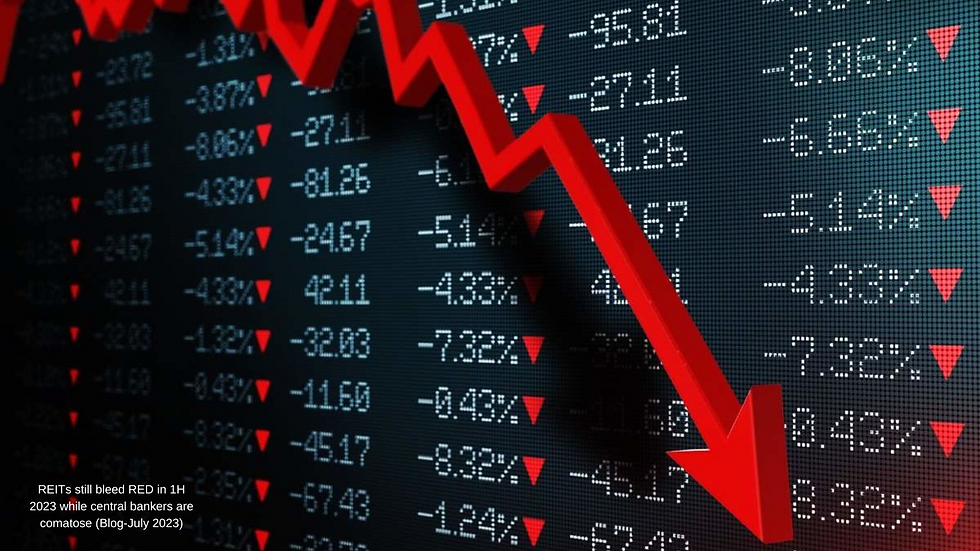THE BEAUTIFUL CORRECTION 2
- by Gabriel Yap

- Nov 18, 2017
- 4 min read
11/2015-
The recent market correction, brought on by a cocktail of fears arising from China’s RMB devaluation, Greece debt problems compounded into possible competitive devaluations of Emerging Market currencies is another vindication of the need to incorporate Behavioural Finance in evaluating modern markets.

Do read my earlier article at einvesthub.btonline.com.sg/incorporatingbehavioralfinanceinmodernmarkets.
Global markets react to all sorts of news and data. However, all hell broke when China’s devalued the yuan against the US$ by 1.8% on Aug 11th. In a classic fear-driven market, herd instinct developed into manic stampedes in the week of Aug 24th where forced sellers were dragged along by short sellers. In the blink of an eye, tons of fears ranging from a possible devaluations of emerging market currencies to China’s slower growth impact on the world economy surfaced.
This nervousness turned into madness when Kazakhstan also devalued its currency – the tenge by abandoning a peg to the US$ and allowing market forces to set the price.
Immediately, the tenge collapsed 27% against the US$. The Kazakh economy is heavily dependent on oil, which has fallen 30% to new lows. A deeper fear griped investors that it could be the start of competitive devaluations amongst export countries trying to shove up their flagging economies.
Shanghai stocks got smashed by 4% while Hong Kong’s Hang Seng Index slipped 5% on Friday 21st Aug, leading the decline in Asia. That same day, the local FTSTI sank below 3,000, last seen in Feb 2014.
Europe and US markets followed suit with matching plummeting plunges of 5-6% for the week ended-21st August.
As Central Banks sat and waited over the weekend, causative madness takes on a new dimension as markets re-opened on the week of 24th August, leading to another “Black Monday”.
Not surprisingly, Shanghai led the causative madness as stocks tanked 8.5% on Monday 24th August while most Asian indexes plummeted to new lows not seen since 2012. The local FTSTI hit a low of 2,843, a whopping 617 point drop or 17.83% decline since 20th May 2015 when the FTSTI started to be battered by a potent mix of Greece debt problems, pending lift-off of interest rates by the Federal Reserve and “Black Monday 24th Aug”.
Wary Europe woke up and sold off by more than 5% setting the stage for the mother of madness – the US market opened with the Dow Jones almost a 1,100 points down and the S&P down almost 120 points within minutes of the opening bell (bringing back memories of the GFC when the Dow closed 777 points down on 15th Sep 2008).
If there is one thing we have learned from the Global Financial Crisis of 2008, it is that markets’ madness and nervousness feed on themselves.
To me, this is Lesson No 1.
During this correction, we have had no short of market predictors or analysts conjuring up all sorts of reasons why a crash or apocalypse was just round the corner. Not surprisingly, these naysayers had not warned of such a correction, if indeed they were that smart.
Equally prevalent is this correction was the difficulty in convincing fear-stricken clients to hold their nerve, refrain from selling in sharply down markets and ride through this downturn. To liquidate investments at the height of a correction or crisis, especially if you do not need the funds, is absolutely foolish. Yet, you have investors who would do that. No matter how intelligent they can be, their nerves gave way and they got sucked into a stampede, only to regret later.
Thus, Lesson No 2 is “Be greedy when markets are bloody” will remain the domain of good investors. I have always advocated that such investors should always steel their psychological make-up as much as they should spend time analyzing company’s cash flows to secure maga-baggers.
This has been the 8th correction for the FTSTI this current decade. Stretching from 20th May 2015 (when problems relating to Greece surfaced) to “Black Monday 24th Aug 2015” of 2,843, the FTSTI had spiraled down 617 points or 17.83%. This is the second-sharpest correction, the sharpest being 1st Aug 2011 to 5th Oct 2011 during the First Greece Debt problem. The FTSTI then corrected a whopping 697 points or 21.55% from 3,215 to 2,522.
This compare to the average correction of 358 points or a drop of 11.04%. To me, such correction magnitude signified for me that a large part of market fear was already in the price and it was the kinda market bottom I was looking for to re-enter markets.
Lesson No 3 would be –
There has never been a correction that has not proven to be a great buying opportunity.
In the sharpest correction of the current decade in 2011 prior to the current, the FTSTI recovered by 326 points or 12.93% in the next 1 month. In fact a study of the previous 7 market corrections, the market posed an average return of 212 points or 8.38% in the next 3 months. Not surprisingly, if the smart investor had listened to market prognositicators, he/she would have missed this current rebound.
Time and again, the lessons from past market experiences have always held good –
Markets’ madness and nervousness feed upon themselves. Listen to the doomsayers and your portfolios will be doomed.
Be greedy when others are fearful – it’s always easier in theory.
Market corrections can be profitable – make it profitable for you as it has been for me all these decades.
Happy Investing!




Comments